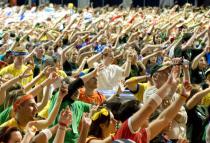
UNIVERSITY PARK – More than 170 students from the College of Communications will have the opportunity to gain hands-on experience when they work together to produce live coverage of the Penn State Dance Marathon for the seventh year in a row this weekend.
A webcast of the 46-hour event represents one of the most visible annual efforts by students. The combined coverage includes the webcast and a live audio stream as well as photojournalism and multimedia reports throughout the weekend — all of which may be found on ComMedia (http://psucommedia.com/), the showcase site for student work in the College of Communications.
THON, the largest student-run philanthropy in the world, is a year-round effort that raises funds and awareness for the fight against pediatric cancer, culminating with a two-day, no sitting and no sleeping marathon. This year’s event begins at 6 p.m. Friday, Feb. 18, and runs until 4 p.m. Sunday, Feb. 20, at the Bryce Jordan Center on the University Park campus.
Telecommunications students from COMM 498F Webcast Production taught by senior lecturer Maria Cabrera-Baukus are responsible for each producing a segment of the live webcast, and they will also work in crew positions during production. Students from several different majors will assist with the effort.
“The webcast is a great way to give to the community. For the students participating in the webcast, it is an opportunity to experience a live television production and practice their skills,” said Cabrera-Baukus, who has abundant professional experience in television. “It’s exciting. You can feel the energy, and it’s a great experience.”
The webcast also will be available at http://www.thon.org and televised on Campus Cable, the University Park cable television system. Production will be directed from a suite on the concourse level of the Bryce Jordan Center.
As the result of a collaborative effort by communications faculty, students and staff, the webcast will include simulcast commentary on ComRadio, the online radio station based in the College of Communications. That combination will produce live interviews with THON participants and up-to-date features, information and profiles during the event.
Journalism students will regularly update information about THON at ComMedia online with multimedia reports, photo packages and stories.
“Centre County Report,” the weekly news program produced by students in COMM 480 Television News, will cover the event throughout the weekend and produce three specials that will air on ComMedia HD on Campus Cable.
More than a half dozen faculty members in the College of Communications have students covering the event, and much of the student-produced work will be available in real time at ComMedia online.
A similar number of faculty and staff will provide hands-on support with the webcast. Other Penn State departments and units, including Information Technology Services and Penn State Public Broadcasting, are supporting the production as well.
“My job as the webcast producer is to plan the whole production, but my main job as a professor is to train my students for webcast productions on their own,” said Cabrera-Baukus, adding that the primary focus of the webcast is to provide a live feed for those who cannot attend the 46-hour event in person, such as THON families, dancers’ families, alumni and students.
Last year’s webcast attracted more than 10,000 simultaneous views. Those visitors came from throughout the United States and more than four dozen foreign countries. Foreign countries that produced the most online visitors included: Argentina, Australia, Canada, France, Germany, Ireland, Italy, Spain and the United Kingdom.
Along with the important goal to chronicle and document THON, the webcast has grown in the past few years with improved production techniques that allow truly timely updates from the dance floor as well as interviews to better convey the work of the thousands of students who make THON a reality each year.
“Students producing the webcast get an excellent real-world opportunity to apply the skills and knowledge they have learned in the classroom,” said Matt Jackson, head of the Department of Telecommunications. “At the same time, THON and the community benefit from increased awareness and more money raised for charity.”
Online donations to THON have increased regularly since the live webcast efforts started.
Established in 1973, THON has raised more than $69 million for The Four Diamonds Fund at Hershey Medical Center. Because of THON’s support, the Fund is able to offset the cost of treatment that a family’s insurance won’t cover, as well as provide for other expenses that may affect the welfare of the child. The Fund also supports the medical team that cares for the children and funds pediatric cancer research through start-up grants and the Four Diamonds Pediatric Cancer Research Institute. THON raised $7.4 million last year.
Steve Sampsell, Penn State University


